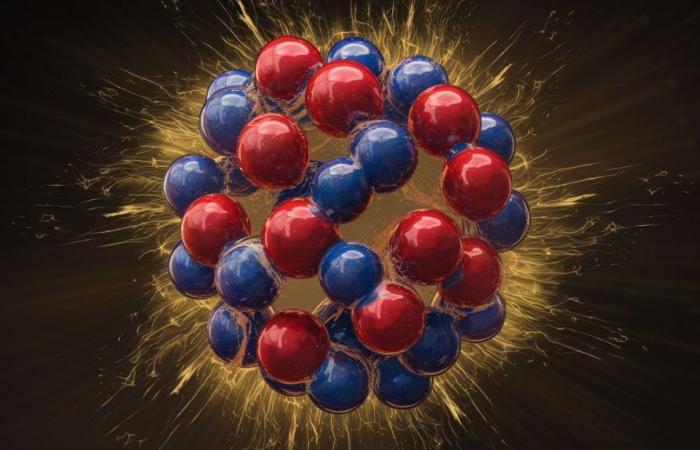The stability of an atomic nucleus can be measured by the energy required to dislodge its nucleons (protons and neutrons) from the outermost orbitals. In so-called magic nuclei, whose orbitals are entirely populated, theenergy necessary is generally greater. One of them, oxygen-28, however, seems to escape this rule.
A team from the SAMURAI21-NeuLAND collaboration demonstrated, through the study of a very close nucleus, fluorine-30, that this nucleus is ultimately not magical and that its nucleons are not held more firmly there. Instead, a regime of superfluidity sets in, where neutrons jump effortlessly between entangled orbitals.
Since taking up the challenge of studying oxygen-28, scientists from the SAMURAI collaboration in Japan, in which physicists from IN2P3 participate, have gone from surprise to surprise. The latest one is not the least.
This nucleus, composed of 8 protons and 20 neutrons, is particularly interesting because, despite its intrinsic characteristics, which should make it a “magical” nucleus, more stable than its neighbors, it turns out to be highly unstable: its lifespan does not exceed 10-20 seconds.
Physicists therefore sought to better understand its intrinsic functioning in order to assess whether or not it should be considered magical. And what they found was very interesting. The victory of instability is due to a rapprochement of the orbitals in which the nucleons are arranged, which allows the installation of a superfluidity regime.
Superfluidity? To fully understand this phenomenon, let’s dive back into the basics of nuclear physics.
In atomic nuclei the rule is that when one of them has exactly the number of nucleons to complete its orbitals, it is more stable and is called magical. This effect will also be increased tenfold if this optimal filling concerns both protons and neutrons. We then speak of a doubly magical core.
Oxygen-28, with its 8 protons and 20 neutrons, is part of this super-category and as such it should, in theory, have enhanced stability. But another equally implacable rule of physics nuclear acts in sense inverse. This time it is the difference between the number of protons and the number of neutrons that comes into play.
The most stable nuclei have a substantially identical quantity. But as a difference widens, the nuclei become less and less stable. With 20 neutrons and 8 protons, oxygen-28 has a very strong tendency to instability. And in the end there is no picture: with its tiny lifespan, it is clear that the rules of instability reign supreme. It remained to be seen why.
To probe the magic of oxygen-28, scientists will seek to compare the energy needed to snatch a neutron from oxygen-28 with that needed to do the same with oxygen-29, which has a neutron of more. The idea being that magical oxygen-28 should hold its neutrons more tightly than oxygen-29. However, the ultra-short lifetime of these two isotopes and especially the decay mode of oxygen-29 make this test extremely difficult.
The scientists from the SAMURAI21-NeuLAND collaboration therefore proposed to get around the problem by studying nuclei very close in number of nucleons, such as fluorine-30 (9 protons, 21 neutrons) and fluorine-29 (9 protons, 20 neutrons) . The proximity between the two elements makes it possible to extrapolate the result of the fluorine isotopes to those of oxygen.
The measurements obtained are clear: the energy required to eject a neutron at each of the two isotopes of fluorine is comparable, which proves that the “magic” and stabilizing configuration with 20 neutrons no longer exists.
“We believe that in this configuration, involving very loosely linked and very unstable nuclei, the very distinct orbitals that we usually find give way to a tangle of orbitals between which the neutrons can circulate freely, explains Olivier Sorlin, researcher at GANIL and having participated in the SAMURAI21-NeuLAND study. This new regime that is establishing itself is probably that of superfluidity, where neutrons pair with each other and jump from one orbit to another in an undifferentiated manner. In this context, the rules of magic, determined by the completeness or not of certain orbitals, no longer apply. This is why oxygen-28 is not magic“.

Graph presenting the evolution of the separation energy (Sn) of the last neutron of Fluorine isotopes. The oscillations of the curve are due to the fact that, as neutrons evolve in pairs, this energy is systematically higher in isotopes containing an even number of neutrons than in those hosting an odd number: tearing off an isolated neutron requires less energy. Between fluorine-29 and fluorine-30, we see that these oscillations remain constant. This proves that the neutron orbitals are indeed intertwined. The presence of the magic number N=20 would have induced a drop in Sn between fluorine-29 and fluorine-30.
But the surprises don’t stop there. While this is the first time that a superfluidity regime has been observed for exotic nuclei, scientists were also able to make another troubling observation.
“Until now, we thought that the pairing of neutrons in a context of superfluidity took place in the atomic nucleus only over long distances, when the two neutrons of a pair are found in regions far from the nucleus, continues Olivier Sorlin. However, theoretical models which reproduce the experimental results of fluorine and oxygen nuclei propose that the pairs of neutrons are much closer. If this result were to be confirmed by new, more specific experiments planned by the SAMURAI collaboration, this would reshuffle the cards in terms of superfluidity.“.
We understand, with this surprise appearance of superfluidity instead of magic, the SAMURAI collaboration has opened the way to an exciting new quest.






